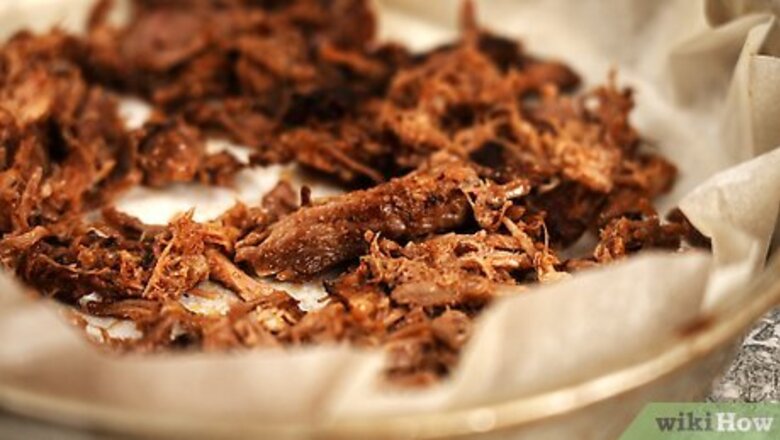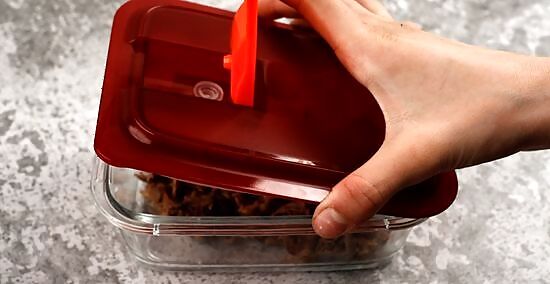
views
- Heat leftover pulled pork in the oven at 250 °F (121 °C) for 30 minutes if thawed, or boil it sous vide-style in a vacuum sealed bag for about 45 minutes if frozen.
- Use any appliance you have—an air fryer, microwave, grill, or slow cooker—to reheat pulled pork until it’s about 165 °F (74 °C).
- Store the meat and juice separately if you’re freezing your leftovers, or together in the fridge. Refrigerated pulled pork lasts 3-5 days while frozen lasts 2-3 months.
- Use your leftovers to make chili, sandwiches, tacos, nachos, or any meat dish you like!
Reheating Leftovers

Oven Reheat the pulled pork in the oven if you have a huge amount. If your meat is frozen, arrange it in a single layer on a flat dish and let it thaw out on the counter or in the fridge before it goes in the oven. Then, add a splash of apple juice or some BBQ sauce to the meat and mix it all together to keep it from drying out and transfer the meat to an oven-safe tray or pan. Cover the meat in foil and put it in the oven at 250 °F (121 °C) for 30 minutes or until reaching an internal temperature of 165 °F (74 °C). For faster thawing, defrost the meat in the microwave or in the oven in low-medium heat. Add some water to keep it from drying out.

Sous vide Boil your pork sous vide-style to heat it straight from frozen. Opt for this method if you stored your pork in a vacuum sealed bag (if you didn’t, just transfer it into one before boiling). Bring a pot of water to about 170 °F (77 °C), then turn off the burner. Place the bag in the water for about 45 minutes, then remove it. Once the meat is heated, open the bag, add your preferred sauce, and enjoy! Most vacuum sealed bags for food storage are safe to boil, so don’t worry about any chemicals seeping into your food. Reheating this way takes a while, but it preserves the fresh, smoky flavor of the pulled pork better than other methods.

Microwave Use the microwave for the quickest and easiest reheating. First, thaw your meat on the counter or in the fridge if it’s frozen. Then, transfer it to a microwave-safe dish and add a splash or apple juice or BBQ sauce for moisture. Microwave on high in 1-2 minute intervals until the pork reaches an internal temperature of 165 °F (74 °C). Use a food thermometer to check the pork’s temperature.

Stovetop Heat the pork in a Dutch oven on your stovetop to retain moisture. Thaw your pork if frozen, then place it in a Dutch oven or a large pot. Add as much leftover juice as you can, then cover with a lid. Set the burner to a medium heat and stir occasionally while the meat heats up. Heat the leftover pulled pork until it reaches an internal temperature of about 165 °F (74 °C). Add additional juice, sauce, or apple juice to the pot for more moisture.

Air fryer Use an air fryer to quickly reheat small batches of leftover pork. Thaw the pork if frozen, then load it into the air fryer and spread it evenly over the tray. Add just a few drops of water, juice, or sauce to help keep it moist, but not a lot since steam can damage your air fryer. Fry for 5-6 minutes at 320 °F (160 °C), then drain any excess liquid. Add BBQ sauce if desired and fry for 1 more minute. Let the meat rest for 3-4 minutes before serving.

Instant pot Reheat your pulled pork in an instant pot to lock in moisture. Add a small amount of water to the pot (check the directions for your specific model) and place the trivet inside. Put your pork in a microwave-safe dish and place it on the trivet without covering it. Close the instant pot lid and steam the pork for about 5 minutes. Open the lid and check for an internal temperature of 165 °F (74 °C). If it’s not warm enough, keep reheating in 2 minute intervals until it’s ready.

Slow cooker Warm up your leftovers in a slow cooker to keep it juicy. Put your pork and all of its juice in your slow cooker or crock pot, put on the lid, and set the cooker to warm. Let the meat heat up for 2-4 hours (depending on how much is in there). Check for a temperature of 165 °F (74 °C) before serving. Easily add other ingredients to the slow cooker if you plan on making a stew, soup, or chili with your leftover pulled pork.

Grill Grill your leftovers over indirect heat to prevent drying out. Heat one side of your grill so that there’s a very hot side and a cooler side that’s about 225 °F (107 °C). Then, mix sauce into your leftover pork and then wrap it in 2 layers of foil. Put the pork on the cool side of the grill and heat until it’s 165 °F (74 °C) (the indirect heat preserves moisture). For enhanced texture, unwrap the meat and toss it with more sauce. Re-wrap it and put it on the hot (direct) side of the grill for 1-2 more minutes. Let the meat rest for 1-2 minutes before serving. If you’re using a pellet grill, reheat the pork the same way you would in the oven.
Proper Storage for Pulled Pork

Skim the fat out of the pork juice before storage. Strain the juice from the pork and let it sit on the counter until a fatty layer forms at the top (put the juice in the fridge to speed up the process). Use a spoon to scoop the fat away, or strain the juice again to separate the fatty layer. Add the juice back to the meat for short term storage in the fridge, or keep it in a separate container if you plan on freezing the pork. Removing the fat allows you to keep the moisture in the pork while making it slightly healthier.

Store leftover pork in a vacuum bag for short term storage or freezing. Let the pork cool down, then portion it out into vacuum seal packs. Fold the open edge closed, then run it through your sealer to create an airtight sack. The pork will last 3-4 days in the fridge, or 2-3 months in the freezer. Use freezer bags with as much air pushed out of them as possible in a pinch. If you’re freezing the pork, store the juice or sauce in a separate container. The liquid can cause the pork to freeze in huge chunks which are hard to reheat.

Wrap the pork tightly in foil if you’re going to eat it within 1-2 days. Spoon the pork onto a sheet of foil and wrap it as tightly as possible, then pinch off the ends so no rogue meat can escape. If there’s very runny juice or sauce with the pork, store it in an airtight plastic container or a bag. Foil isn’t airtight, so the chances of the pork going bad are higher. Eat the leftovers within a day or two to avoid food poisoning.

Keep extra pulled pork in an airtight food storage container. Spoon your pork into a plastic or glass storage container with a lid that seals tightly. If you’re freezing it, separate the juice from the meat and store in a separate container (you can store the meat with or without the juice in the fridge). Eat refrigerated pork within 3-5 days.
Easy Meal Ideas

Use leftover pork to make decadent nachos. Toss your leftover meat with cumin, paprika, and garlic powder, then reheat it in the oven. Spread tortilla chips over a sheet pan, then add your heated pork, some black beans, and cheddar and Monterey jack cheese. Then, toss it in the oven until the cheese is melted. Add your favorite toppings once your nachos are out of the oven. Try salsa, sour cream, guacamole, jalapeños, or whatever else sounds good!

Make delicious pulled pork chili. Combine your leftover meat (about 1 lb (450 g)) with a can of chili beans, a can of black beans, 4 oz (110 g) of canned green chilies, 3 cans of fire roasted tomatoes, and 4 oz (110 g) of sweet corn in a pot or slow cooker. Season with red pepper flakes, cumin, and paprika and simmer on low for 3-4 hours to cook the chili. Serve with shredded cheddar cheese and sliced avocado. Get adventurous and add pulled pork to your own chili recipe. Try it out in stews and soups, too!

Chow down on pulled pork tacos. Slap your reheated pork onto some warm tortillas and add your favorite taco toppings like sour cream, avocado, shredded cheese, beans, or salsa. This is a super simple way to make a delicious meal and keep your leftover pork from going to waste! Try making a taco salad or burrito bowl with your pork, too. Make a base of rice or greens, then add your meat and favorite toppings.

Go for a classic pulled pork sandwich. Pile your tasty leftovers onto your favorite bread or a bun and add mustard, pickles, cheese, or whatever else you like. If you’re craving something new, try making sliders on mini-buns or even sandwiching some pork into a grilled cheese. The options are limitless! Coleslaw and pulled pork are best friends. Eat a big dollop as a side, or even put it right on your sandwich. Go crazy with your leftovers. You can add pulled pork to pizza, egg rolls, empanadas—basically any food!
How many times can you reheat pulled pork?

Reheat pork as often as you like as long as it reaches 165 °F (74 °C). Make sure the center of your pulled pork portion is piping hot each time you reheat it to prevent bacteria growth (check the temperature with a food thermometer to be extra sure). It needs to be hot because every time you pull the meat out of the fridge or freezer, you’re exposing it to the “danger zone” of temperatures (41 °F (5 °C) to 135 °F (57 °C)) where bacteria can grow. That doesn’t mean your pork will taste great forever, though. It’s still recommended to toss your leftovers after 5-7 days since the quality and taste decrease each time you reheat it.




















Comments
0 comment